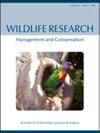Hybridisation rates, population structure, and dispersal of sambar deer (Cervus unicolor) and rusa deer (Cervus timorensis) in south-eastern Australia
IF 1.6
3区 生物学
Q3 ECOLOGY
引用次数: 3
Abstract
ABSTRACT Context Introduced populations of sambar deer (Cervus unicolor) and rusa deer (Cervus timorensis) are present across south-eastern Australia and are subject to local population control to alleviate their negative impacts. For management to be effective, identification of dispersal capability and management units is necessary. These species also readily hybridise, so additional investigation of hybridisation rates across their distributions is necessary to understand the interactions between the two species. Aim Measure the hybridisation rate of sambar and rusa deer, assess broad-scale population structure present within both species and identify distinct management units for future population control, and measure the likely dispersal capability of both species. Methods In total, 198 sambar deer, 189 rusa deer, and three suspected hybrid samples were collected across Victoria and New South Wales (NSW). After sequencing and filtering, 14 099 polymorphic single-nucleotide polymorphism (SNP) markers were retained for analysis. Hybridisation rates were assessed before the data were split by species to identify population structure, diversity indices, and dispersal distances. Key results Across the entire dataset, 17 hybrids were detected. Broad-scale population structure was evident in sambar deer, but not among the sites where rusa deer were sampled. Analysis of dispersal ability showed that a majority of deer movement occurred within 20 km in both species, suggesting limited dispersal. Conclusions Distinct management units of sambar deer can be identified from the dataset, allowing independent population control. Although broad-scale population structure was not evident in the rusa deer populations, dispersal limits identified suggest that rusa deer sites sampled in this study could be managed separately. Sambar × rusa deer hybrids are present in both Victoria and NSW and can be difficult to detect on the basis of morphology alone. Implications Genetic analysis can identify broad-scale management units necessary for population control, and estimates of dispersal capability can assist in delineating management units where broad-scale population structure may not be apparent. The negative impacts associated with hybridisation require further investigation to determine whether removal of hybrids should be considered a priority management aim.澳洲东南部黑鹿(Cervus unicolor)和红鹿(Cervus timorensis)的杂交率、种群结构和分布
摘要背景引进的鹿(Cervus unicolor)和鹿(Cervus timorensis)种群分布在澳大利亚东南部,并受到当地种群控制以减轻其负面影响。为使管理有效,必须确定扩散能力和管理单位。这些物种也很容易杂交,因此有必要对其分布中的杂交率进行额外的调查,以了解两种物种之间的相互作用。目的测定三鹿和鹿的杂交率,评估两种鹿的大范围种群结构,确定未来种群控制的不同管理单位,并测量两种鹿可能的扩散能力。方法在维多利亚州和新南威尔士州共采集沙鹿198只、沙鹿189只和疑似杂交鹿3只。测序筛选后,共获得14099个单核苷酸多态性(SNP)标记供分析。在按物种划分数据之前,对杂交率进行评估,以确定种群结构、多样性指数和扩散距离。在整个数据集中,共检测到17个杂交品种。大尺度的种群结构在山鹿中很明显,而在鹿的取样点中则不明显。分散能力分析表明,两种鹿的大部分活动发生在20 km范围内,表明其分散程度有限。结论从数据集中可以识别出不同的管理单位,可以进行独立的种群控制。虽然大范围的种群结构在鹿群中并不明显,但所确定的分散限度表明,本研究取样的鹿群可以单独管理。在维多利亚州和新南威尔士州都有Sambar × rusa鹿的杂交品种,仅凭形态学很难发现。遗传分析可以确定种群控制所需的大规模管理单元,而对分散能力的估计可以帮助划定大规模种群结构可能不明显的管理单元。与杂交相关的负面影响需要进一步调查,以确定清除杂交是否应被视为优先管理目标。
本文章由计算机程序翻译,如有差异,请以英文原文为准。
求助全文
约1分钟内获得全文
求助全文
来源期刊

Wildlife Research
生物-动物学
CiteScore
4.30
自引率
15.80%
发文量
56
审稿时长
3 months
期刊介绍:
Wildlife Research represents an international forum for the publication of research and debate on the ecology, management and conservation of wild animals in natural and modified habitats. The journal combines basic research in wildlife ecology with advances in science-based management practice. Subject areas include: applied ecology; conservation biology; ecosystem management; management of over-abundant, pest and invasive species; global change and wildlife management; diseases and their impacts on wildlife populations; human dimensions of management and conservation; assessing management outcomes; and the implications of wildlife research for policy development. Readers can expect a range of papers covering well-structured field studies, manipulative experiments, and analytical and modelling studies. All articles aim to improve the practice of wildlife management and contribute conceptual advances to our knowledge and understanding of wildlife ecology.
Wildlife Research is a vital resource for wildlife scientists, students and managers, applied ecologists, conservation biologists, environmental consultants and NGOs and government policy advisors.
Wildlife Research is published with the endorsement of the Commonwealth Scientific and Industrial Research Organisation (CSIRO) and the Australian Academy of Science.
 求助内容:
求助内容: 应助结果提醒方式:
应助结果提醒方式:


